Visual Distress Signals
The Regulations
This information is directed primarily to recreational boaters, but the requirements discussed also apply to operators of vessels engaged in the carrying of six or fewer passengers. The Visual Distress Signal requirements for most commercial vessels are in Title 46 of the Code of Federal Regulations. The requirement to carry visual distress signals became effective on January 1, 1981. This regulation requires all boats when used on coastal waters, which includes the Great Lakes, the territorial seas and those waters directly connected to the Great Lakes and the territorial seas, up to a point where the waters are less than two miles wide, and boats owned in the United States when operating on the high seas to be equipped with visual distress signals.
The only exceptions are during daytime (sunrise to sunset) for:
- Recreational boats less than 16 feet in length
- Boats participating in organized events such as races, regattas or marine parades
- Open sailboats not equipped with propulsion machinery and less than 26 feet in length
- Manually propelled boats
These boats only need to carry night signals when used on these waters at night.
Types of Visual Distress Signals
A wide variety of signaling devices, both pyrotechnic and non-pyrotechnic, can be carried to meet the requirements of the regulation.
- Recreational boats less than 16' operating in coastal waters need only carry night signaling devices when operated at night. All other boats must carry both night and day signaling devices.
- Any combination can be carried as long as they add up to three signals for day use and three signals for night use. Three day/ night signaling devices meet both requirements.
Note: If pyrotechnic devices are selected, a minimum of three must be carried. Pyrotechnic devices come with an expiration date, which is 42 months from the date of manufacture. To meet carriage requirements, you must have at least three un-expired flares aboard. You may carry expired flares as back up, but they will not count towards the legal requirement.
The following details a combination of devices which can be carried in order to meet the requirements:
- Three hand-held red flares (day and night). Flares must be under 42 months of age.
- One electric distress light (night only).
- One hand-held red flare and two parachute flares (day and night). One hand-held orange smoke signal, two floating orange smoke signals (day) and one electric distress light (night only). Flares must be under 42 months of age.
Pyrotechnic Visual Distress Signaling Devices
Must be Coast Guard approved, in serviceable condition and stowed to be readily accessible. If they are marked with a date showing the serviceable life, this date must not have passed. Launchers produced before Jan. 1, 1981, intended for use with approved signals are not required to be Coast Guard Approved.
USCG Approved Pyrotechnic Visual Distress Signals and Associated Devices include:
- Pyrotechnic red flares, hand held or aerial
- Pyrotechnic orange smoke, hand held or floating
- Launchers for aerial red meteors or parachute flares
The purpose of the regulation is to assure that boaters have a way of attracting attention and securing assistance should the need arise. Properly used visual distress signals will also help reduce the time it takes to locate a boat in difficulty when a search is underway. This will reduce the possibility of a minor emergency becoming a tragedy.
Non-pyrotechnic Visual Distress Signaling Devices
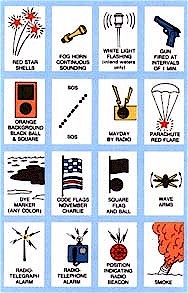
Must carry the manufacturer's certification that they meet Coast Guard requirements. They must be in serviceable condition and stowed to be readily accessible. This group includes:
- Orange distress flag
- Electric distress light
No single signaling device is ideal under all conditions and for all purposes. Consideration should therefore be given to carrying several types. For example, an aerial flare can be seen over a long distance on a clear night, but for closer work, a hand-held flare may be more useful.
SOS Distress Light
The SOS Distress Light is an LED Visual Distress Signal Device that meets U.S. Coast Guard requirements to completely replace traditional pyrotechnic flares. Unlike traditional flares, this electronic flare never expires, which solves the challenge of flare disposal. The LED light flashes up to 60 hours, unlike traditional flares that last minutes or less. It flashes only the SOS sequence, per USCG requirements, and is visible up to 10 nautical miles.
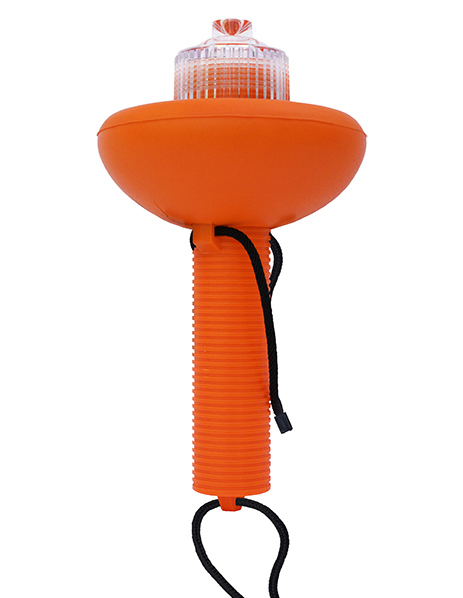
Day Use Only
Hand Held Orange Smoke Distress Signals
Hand held distress signals are very common. Make sure to hold the flare with a glove, and make sure to keep the smoke down-wind of your boat.

Floating Orange Smoke Distress Signals
These come in two varieties, one lasting approximately 5 minutes, one lasting 15 minutes.

Orange Distress Signal Flag for Boats
The distress flag must be at least 3 x 3 feet with a black square and ball on an orange background. It is accepted as a day signal only and is especially effective in bright sunlight. The flag is most distinctive when waved on something such as a paddle or a boat hook or flown from a mast.
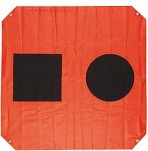
Sea-marker Dye
This is useful when air search has been initiated. Comes in several colors, and should be used when chances of being spotted are high.

Signal Mirror
Although not recognized by USCG as a carriage requirement, a well-handled signal mirror can be very effective in calling attention to oneself. It is low in cost and has an unlimited shelf life.
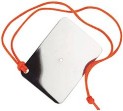
Night Use Only
Electric Distress Light for Boats
The electric distress light is accepted for night use only and must automatically flash the international SOS distress signal, which is three short flashes, three long flashes, and three short flashes. Flashed four to six times each minute, this is an unmistakable distress signal, well known to most boaters. The device can be checked any time for serviceability if shielded from view.
NOTE: An ordinary flashlight is not acceptable since it must be manually flashed and does not normally produce enough candle power. The Regulation States: "No person in-a boat shall display a visual distress signal on water to which this subpart applies under any circumstances except a situation where assistance is needed because of immediate or potential danger to the persons aboard."
Day and Night Use
- Hand Held Flare Distress Signal
- Parachute Red Flare Distress Signals - (25 mm or larger) These signals require use in combination with a suitable launching device.
- Hand Held Rocket-Propelled Parachute Red Flare Distress Signals
- Distress Signal for Boats, Red Aerial
- Pyrotechnic Flare - These devices may be either meteor or parachute assisted type. Some of these signals may require use in combination with a suitable launching device.
Warning:
In some states the pistol launcher for meteors and parachute flares may be considered a firearm. Therefore, check with your state authorities before acquiring such launcher.
Visual Distress Signals: When and How to Use Them
Visual distress signals are part of your boat's safety equipment. Check them before you leave harbor. Their intended purpose is to summon help should the need arise. Visual distress signals can only be effective when someone is in a position to see them. Therefore, when employing pyrotechnic devices, do so only when you see or hear a boat or airplane or you are reasonably sure that someone on shore is in position to see your signal and take action. Good judgment is an essential part of successful use of visual distress signals.
All distress signaling devices have both advantages and disadvantages. The most popular, because of cost, are probably the smaller pyrotechnic devices. Pyrotechnics make excellent distress signals, universally recognized as such, but they have the drawback that they can be used only once. Additionally, there is a potential for both injury and property damage if not properly handled.
Pyrotechnics devices have a very hot flame, and the ash and slag can cause burns and ignite material that burns easily. Projected devices, such as pistol launched and hand-held parachute flares and meteors, have many of the same characteristics of a firearm and must be handled with the same caution and respect.
The hand-held and the floating orange smoke signaling devices are excellent (if not the best) day signals, especially on clear days. Both signals are most effective with light to moderate winds because higher winds tend to keep the smoke close to the water and disperse it which makes it hard to see.
Red hand-held flares can be used by day, but are most effective at night or in restricted visibility such as fog or haze. Only Coast Guard or SOLAS flares are acceptable for use on recreational boats. When selecting such flares look for the Coast Guard approval number and date of manufacture. Make sure that the device does not carry the marking: "Not approved for use on recreational boats," and that no more than 3 years have passed since manufacture.
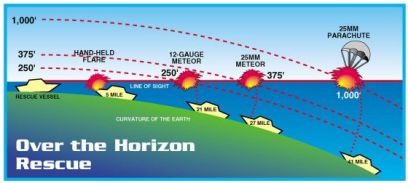
If you See a Visual Distress Signal in the Distance
The unwritten law of the sea requires that a mariner come to the aid of a mariner in distress. Therefore, should you see a distress signal, immediate and positive action should be taken. Notify the nearest Coast Guard station or State authority by radio. Channel 9 on CB and Channel 16 on VHF marine radio (156.8 MHz) are recognized distress channels. If you can assist the stricken vessel without endangering yourself, you should. The Federal Boat Safety Act of 1971 contains a "Good Samaritan" clause stating: "Any person ....who gratuitously and in good faith renders assistance at the scene of a vessel collision, accident, or other casualty without objection of any person assisted, shall not be held liable for any act or omission in providing or arranging salvage, towage, medical treatment, or other assistance where the assisting person acts as an ordinary, reasonably prudent man or woman would have acted under the same or similar circumstances."
Flags
Flags serve a variety of purposes in the marine environment. There is no legislation governing the flying of any flag on numbered, undocumented or licensed vessels. However, there is a proper etiquette involved when displaying flags.
Recreational boaters may fly flags to display boating affiliations. For example, many yacht clubs provide triangular shaped burgees to members. And, members of the U.S. Power Squadrons and U.S. Coast Guard Auxiliary fly flags to identify themselves. Boaters also fly flags to identify their home state or nationality.
Flags are also used for specific boating activities and navigational purposes. For example, boats with scuba divers must fly a "diver down" flag when divers are in the water. There are two types of diver down flags and both are appropriate to display. They are a red flag with a white diagonal stripe and a rigid replica of an "alfa" flag.
Another example is the flags used by committee members and participants of events sponsored by the US Sailing, the governing body of sailboat racing.
Flags are also used to signal your need for help. When in distress, a boat should fly an orange flag with a black square and black ball. A man overboard flag, consisting of the letter "O", can be fixed to a staff which is in turn fixed to a life ring.

Alfa
Diver down

Bravo
Dangerous cargo

Charlie
Yes

Delta
Keep clear

Echo
Altering to starboard

Foxtrot
Disabled

Golf
Want a pilot

Hotel
Pilot on board

India
Altering to port

Juliette
Keep clear

Kilo
Desire to communicate

Lima
Stop immediately

Mike
I am stopped

November
No

Oscar
Man overboard

Papa
About to sail

Quebec
Request clearance into port (int'l)

Romeo
Preparing to replenish (at sea)

Sierra
Engines going astern

Tango
Keep clear of me

Uniform
You are running into danger

Victor
I require assistance

Whiskey
Need medical assistance

X-Ray
Watch for my signals

Yankee
Dragging anchor

Zulu
Require tug

